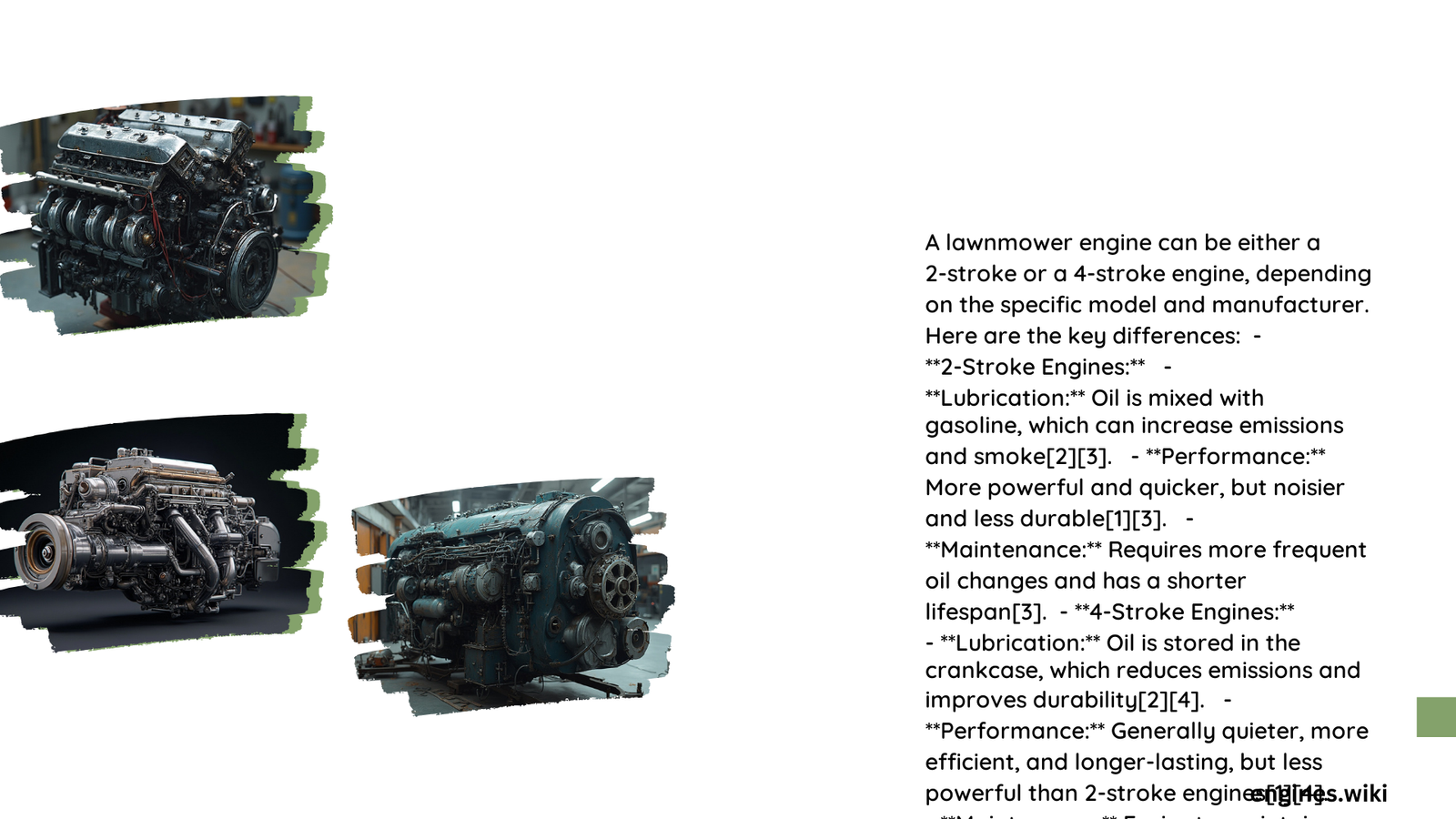Lawnmower engines typically come in two types: 2-stroke and 4-stroke. The majority of modern lawnmowers use 4-stroke engines due to their better fuel efficiency, lower emissions, and quieter operation. However, some smaller lawnmowers and handheld lawn care equipment still use 2-stroke engines for their higher power-to-weight ratio. The choice between 2-stroke and 4-stroke depends on the specific lawnmower model and its intended use.
What Are the Main Differences Between 2-Stroke and 4-Stroke Lawnmower Engines?
The primary differences between 2-stroke and 4-stroke lawnmower engines lie in their operating cycles, fuel efficiency, power output, and emissions. Let’s break down these differences:
Operating Cycles
- 2-Stroke Engines:
- Complete a power cycle in two piston strokes (one crankshaft revolution)
- Upstroke: Intake and compression
-
Downstroke: Power and exhaust
-
4-Stroke Engines:
- Complete a power cycle in four piston strokes (two crankshaft revolutions)
- Intake stroke: Draws in air-fuel mixture
- Compression stroke: Compresses the mixture
- Power stroke: Ignites the mixture, driving the piston down
- Exhaust stroke: Expels burnt gases
Fuel Efficiency and Lubrication
| Engine Type | Fuel Efficiency | Lubrication Method |
|---|---|---|
| 2-Stroke | Lower | Oil mixed with fuel |
| 4-Stroke | Higher | Separate oil system |
2-stroke engines typically consume more fuel because they burn oil along with the fuel. 4-stroke engines are more fuel-efficient due to their separate lubrication system.
Power Output and Weight
- 2-Stroke Engines: Higher power-to-weight ratio, making them suitable for handheld equipment
- 4-Stroke Engines: Lower power-to-weight ratio but generally more powerful overall
Emissions and Environmental Impact
2-stroke engines produce higher emissions due to burning oil with fuel. 4-stroke engines are cleaner and more environmentally friendly.
How Do 2-Stroke and 4-Stroke Engines Affect Lawnmower Performance?

The type of engine significantly impacts a lawnmower’s performance:
- Cutting Power:
- 2-stroke engines provide quick bursts of power, ideal for small, lightweight mowers
-
4-stroke engines offer more consistent power, better for larger lawns and tougher grass
-
Fuel Consumption:
- 2-stroke engines consume more fuel, requiring more frequent refills
-
4-stroke engines are more fuel-efficient, allowing for longer operating times
-
Noise Levels:
- 2-stroke engines are generally louder
-
4-stroke engines operate more quietly, which is preferable in residential areas
-
Maintenance Requirements:
- 2-stroke engines have simpler designs, making them easier to maintain
- 4-stroke engines require more complex maintenance but typically have longer lifespans
What Are the Typical RPM Ranges for Lawnmower Engines?
Lawnmower engine RPM (Revolutions Per Minute) ranges vary based on the engine type:
- 2-Stroke Engines: 5,000 to 10,000 RPM
- 4-Stroke Engines: 3,000 to 6,000 RPM
Higher RPM doesn’t always translate to better cutting performance. 4-stroke engines, despite lower RPM, often provide more torque for effective grass cutting.
How Does Engine Stroke Type Influence Lawnmower Selection?
When choosing a lawnmower, consider the following factors related to engine stroke type:
- Lawn Size:
- Small lawns: 2-stroke engine mowers may suffice
-
Large lawns: 4-stroke engine mowers are generally more suitable
-
Terrain:
- Flat terrain: Both types can work well
-
Hilly or uneven terrain: 4-stroke engines often perform better due to higher torque
-
Maintenance Preferences:
- Low maintenance: 2-stroke engines are simpler
-
Longer lifespan: 4-stroke engines typically last longer with proper care
-
Environmental Concerns:
- Stricter emission regulations: 4-stroke engines are more compliant
-
Less concern about emissions: 2-stroke engines may be acceptable
-
Budget:
- Initial cost: 2-stroke engine mowers are often cheaper
- Long-term cost: 4-stroke engines may be more economical due to better fuel efficiency
What Are the Future Trends in Lawnmower Engine Technology?
The lawnmower industry is evolving, with several trends emerging:
-
Increased Focus on 4-Stroke Engines: Due to environmental regulations and consumer demand for efficiency
-
Electric Lawnmowers: Growing popularity of battery-powered and corded electric mowers
-
Hybrid Technologies: Some manufacturers are exploring hybrid gas-electric lawnmower engines
-
Improved Fuel Efficiency: Ongoing research to enhance fuel economy in both 2-stroke and 4-stroke engines
-
Smart Features: Integration of IoT and smart technologies in lawnmower engines for better performance monitoring and maintenance scheduling
In conclusion, while both 2-stroke and 4-stroke engines have their place in the lawnmower market, 4-stroke engines are more common in modern lawnmowers due to their overall better performance, fuel efficiency, and lower emissions. The choice between the two depends on specific needs, but the trend is moving towards more efficient and environmentally friendly options.
References:
1. Small Engine Warehouse – The Difference between 2 Stroke and 4 Stroke Engines
2. Biso Generator – 2-stroke vs 4-stroke small engines: Everything you need to know
3. Prime Source Co. – The Difference Between a 2-Stroke and 4-Stroke Engine
